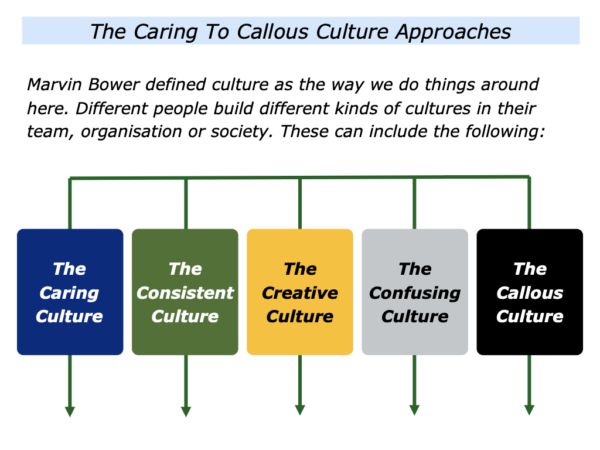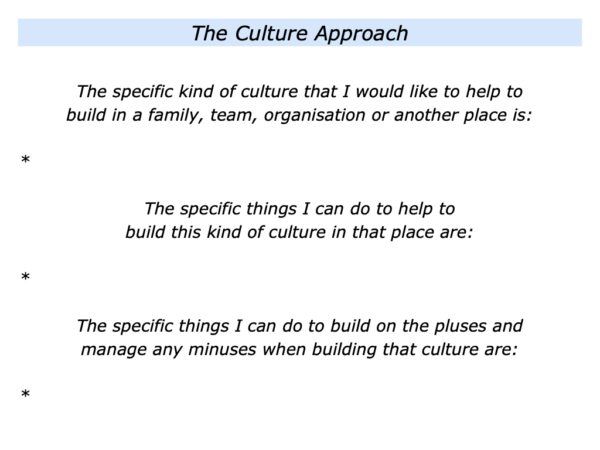
Different people choose to build different kinds of cultures in teams, organisations and societies. Each kind of culture has consequences. Marvin Bower once described culture as:
The way we do things around here.
This piece describes cultures that range from being caring to callous. Some people combine elements of each approach. Let’s explore these themes.
The Caring Culture
Different people build caring cultures in different ways. Some aim to translate caring into action and encourage people in their daily lives and work.
When have you experienced a caring culture? You may have had encouraging parents, educators or managers who created an environment in which people could grow.
During the early years of my career I met many leaders of therapeutic communities who created such places. They had high standards, however, and emphasised that everybody should have this caring ethic.
People who joined the communities needed to understand the ethos. They were expected to take responsibility and encourage others, rather than be irresponsible. The caring principles applied to everybody.
Caring cultures have pluses and some minuses. The pluses are that they create an ethos of kindness, encouragement and respect. This enables people to be themselves, help others and grow.
There are potential minuses. Some people may take advantage of the culture in ways that hurt others. They may then also expect people to excuse them.
Looking back, when have experienced a caring culture? What were the pluses? What were the minuses? What were the lessons you learned from the experience?
The Consistent Culture
Good leaders often build consistent cultures. They are positive, predictable and create an environment in which people can achieve peak performances. Poor leaders are sometimes negative and unpredictable.
Consistent organisations give people clear messages about the following things. They say things like:
The purpose of our organisation is …
The principles we encourage people to follow that are an expression of this purpose – and the reasons for these – are …
The positive results we are aiming to achieve – and the benefits of achieving this picture of success – are …
Such organisations make the professional deal clear. They communicate the responsibilities of both the organisation and the employee. They then invite people to choose whether they want to contribute towards achieving the goals.
Consistent cultures keep sharing success stories and show people what good looks like. They also act decisively if people choose not to follow the required professional standards.
Such cultures have pluses and some minuses. The pluses are that people can feel they are in a predictable environment. They can also follow certain principles to contribute to achieving the picture of success.
There are potential minuses. Sometimes the culture can become a bit staid. People then need to be encouraged to use their creativity to shape the future and deliver ongoing success.
Looking back, when have experienced a consistent culture? What were the pluses? What were the minuses? What were the lessons you learned from the experience?
The Creative Culture
Creative cultures can be stimulating. People enjoy the buzz of working in such environments. They feel alive when using their talents and doing fulfilling work.
Such cultures can be exciting, but they can also unpredictable and disorganised. Sometimes people lapse into pursuing their personal agendas.
Good leaders recognise that people often work best when they align their efforts towards achieving a specific goal. This can be a challenge in creative cultures.
Such leaders therefore take a certain approach. They keep communicating the organisation’s purpose. They then take the following steps to maintain a stimulating environment.
They position the culture as one that keeps running a series of projects that contribute towards achieving the purpose;
They encourage people to choose to opt into contributing to the various projects;
They then enable people to deliver successful projects that contribute towards achieving the purpose.
Such leaders encourage people to be creative but they are also prepared to make tough decisions. This decisiveness may be needed if certain people choose not to contribute to the organisation.
Creative cultures can have pluses and some minuses. The pluses are that people feel they are in a stimulating environment. They are then able to use their strengths to do creative work and deliver success.
There are potential minuses. Such cultures need people who deliver consistently high professional standards. Sometimes they attract people who want to do their own thing and do not contribute helping their colleagues or the organisation to achieve success.
Looking back, when have experienced a creative culture? What were the pluses? What were the minuses? What were the lessons you learned from the experience?
The Confusing Culture
Confusing cultures can exist in the family, workplace and society. They often have the following characteristics.
The leaders or other key people say one thing but do another;
The behaviour of such people causes confusion and others find it hard to get clear answers;
The guidelines and goal posts sometimes keep changing.
People can find such cultures to be frustrating. Why? People like clarity. They like to know the rules of the game. They can then decide whether they want to opt in and work towards achieving success.
Different people respond in different ways in such cultures. Some wait for clarity to appear. Some play safe and retreat into their own worlds. Some decide to move on and find a more predictable situation.
There are few pluses in such a culture but quite a few minuses. The leaders and other key people in the culture may have good intentions but their behaviour can cause confusion. This can create problems for people.
Can you think of a time when you experienced such a culture? What effect did it have on you? How did you try to maintain your health? What were your coping strategies? What did you learn from the experience?
The Callous Culture
Some leaders build callous cultures where they pursue their own agendas and are oblivious to the needs of others. They may aim to hit certain targets by aiming to exploit or control people.
Some may be cruel in the way they behave, treat people or implement policies. They may also get a kick from using their power in a way that hurts other people.
Some leaders enjoy being bullies. Believing they are superior to others, they scapegoat people who are different. Such people may also enjoy spreading fear and hate.
Some people may also be addicted to anger and conflict. They try to make themselves look big by belittling others. They make sure that they win and that other people lose.
There are few pluses to such an approach. Individuals may respond to threats by working harder in the short term but this is unsustainable in the long term. The minuses including spreading pain and creating other collateral damage.
Looking back, have you ever been in such a culture? How did the key people demonstrate their callousness? What effect did this have on you and other people?
How did you manage to deal with the culture? Was there a point when you decided to move on? If so, what was the trigger that led to you making this decision? What were the lessons you learned from the experience?
Let’s return to your own life and work. Looking ahead, can you think of a culture that you would like to help to build in a certain place? You may want to create this in a family, team, organisation or another place.
What is the kind of culture you would like to help to build? You may, for example, want to combine elements of the caring, consistent and creative approaches. If so, you may want to explore the following themes.
How can you create a caring environment? How can you maintain consistency by giving clear messages about the desired standards? How can you encourage people to channel their creativity towards achieving a compelling goal?
Imagine that you are clear about how to build such a culture. What may happen as a result of taking those steps? How can you build on the pluses and manage any potential minuses when helping to build such a culture?
If you wish, try tackling the exercise on this theme. This invites you to complete the following sentences.







Leave a Reply